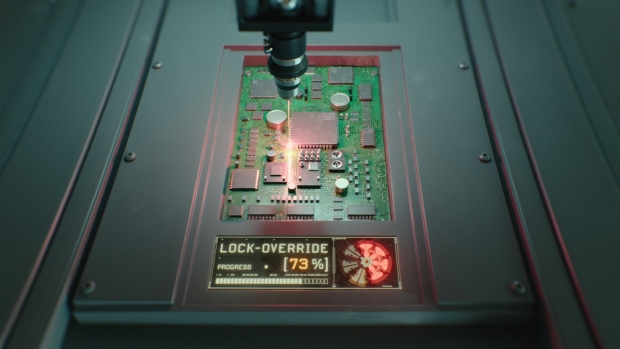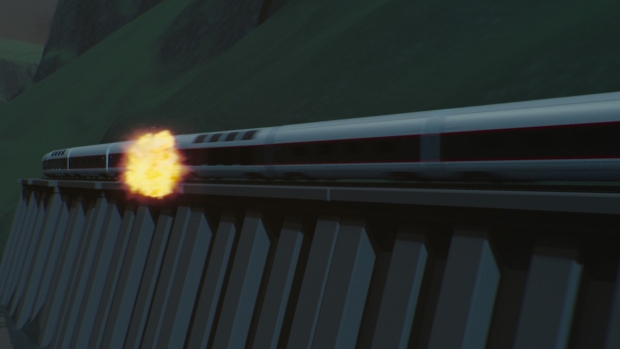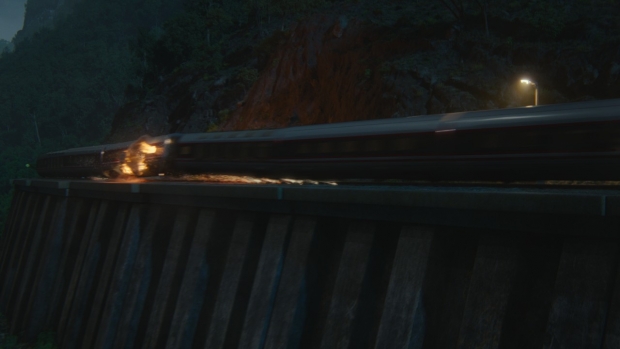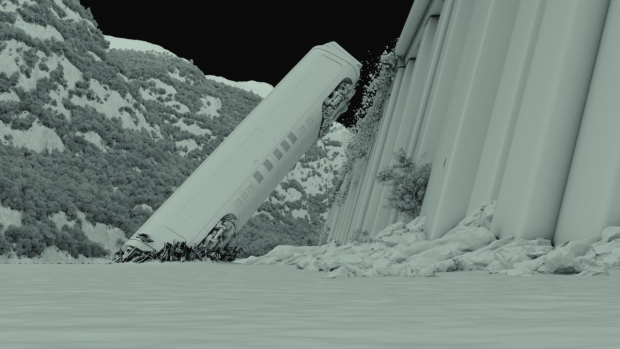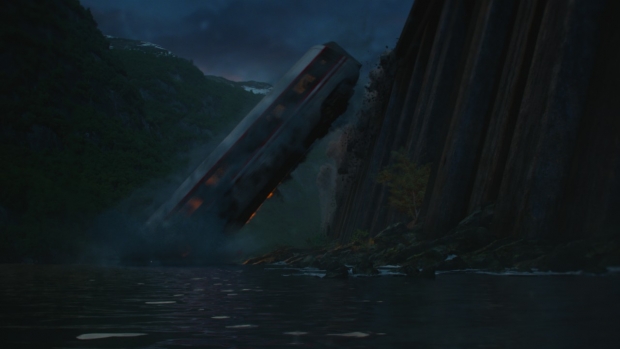Led by VFX supervisor Wes Froud and VFX producer Scott Shapiro, lead vendor DNEG, along with Digital Domain, Distillery VFX, Host VFX, Luma Pictures, Outpost VFX, Perception, RISE, Territory Studios, Visual Creatures, and Zoic Studios, delivered a wide selection of 1,796 VFX shots, ranging from UI motion graphics to an explosive train crash, on the famed MCU directing duo’s new spy thriller series, now streaming on Prime Video.
At first it seemed strange that the famed sibling directorial team of Joe and Anthony Russo would be chosen to helm the bombastic spectacle of the Marvel Cinematic Universe coming from the TV world on shows like Arrested Development and Community as well as the family comedy feature You, Me and Dupree. However, ever since directing Captain America: The Winter Soldier, the brothers have fully embraced their inner action star by choreographing death-defying set pieces that are not for the faint of heart.
In envisioning an international espionage franchise for Amazon Studios, the Russo brothers started off their ambitious creative initiative with the live-action thriller series Citadel, where two operatives who happen to be former lovers are hunted down when their mysterious spy organization is compromised, only to reunite years later with no recollection of one another.
And to illustrate that reunion, there is no shortage of visual effects in the six-episode series, now streaming on Prime Video, that were orchestrated by VFX Supervisor Wes Froud and VFX Producer Scott Shapiro.
1,796 visual effects shots, ranging from UI motion graphics to an explosive train crash, were created by lead vendor DNEG as well as Digital Domain, Distillery VFX, Host VFX, Luma Pictures, Outpost VFX, Perception, RISE, Territory Studio, Visual Creatures and Zoic Studios.
“Coming into any show that has the Russo brothers involved, there is a huge scope and expectation that you need to meet,” states Froud. “Going through COVID-19 times we had difficulty at the beginning of production, but what we had to bring to the table was that extra scope and scale. They looked to us for the big action sequences. You can pick them out from what you’ve seen such as the train in the opening episode and the ski sequence in the Alps in Episode 103. It was a huge undertaking. We had to work hard with many different departments, including stunts and the art department, in how do we integrate this in a way that brings something to television that we haven’t seen before in a spy, action, thriller series.”
Displayed graphics, such as the UI on computer screens and phones, were an instrumental part of the visual language. “We had screens, from a cellphone to floor-to-ceiling glass panels, that we had graphics playing on,” notes Shapiro. “There were quite a lot of specific bespoke effects peppered throughout the series.”
The story takes place in both 2022 and 2030, which is reflected in the graphics. “How do we bridge that gap to give a different aesthetic for when Citadel was at its peak to this broken down more rogue aspect of them operating in the present day?” Froud asks rhetorically. “It was difficult. We worked closely with the production designers [Scott Chambliss, Richard L. Johnson] and David Weil, the showrunner, who has a good eye and understanding for visual graphic storytelling. Do we go Star Wars or Minority Report? It’s a fine balance of coming up with a visual aesthetic and trying to find a real story point within the graphics to get that point across to the audience. Territory Studio was our main graphic vendor, and they were fantastic in helping us develop all these graphics.”
Executing the big action and fight scenes required close collaboration between stunts, special effects, and visual effects. “The three departments worked well together,” states Shapiro. “We had a fantastic stunt supervisor and coordinator, James Young, who did extensive stuntvis ahead of time to layout the sequence and get approval; he worked closely with [our leads] Priyanka Chopra Jonas and Richard Madden. Both Priyanka and Richard were game to do the necessary rehearsals and choreography to make sure that they understood the fight.”
“The train sequence was shot in a train car onstage in Atlanta,” he continues. “It was a confined space with a lot going on in the choreography and trajectory of the fight. Fighting with guns and stuff from the tabletop, essentially using whatever was available for hand-to-hand combat. Onset the filmmakers were good about sticking with the plan. There were times where adjustments had to be made and the filmmakers were receptive to that. Even though the train sequence looks quite complex, it came together quite naturally because of the planning beforehand.”
The pace is fast on a Russo production. “Joe has finalled close to 10,000 visual effects shots in his career so he understands the process of how we go about this,” observes Froud. “The way the team worked on this was fluid. We would lean on departments and departments would step in when necessary. For these fights it was down to the stuntvis that James Young’s team had done, and it allowed us to get the edits together extremely quickly and efficiently. The great thing with them is they come to you early, as typically in post-production we’re usually stuck with the things that didn’t work and have to fix them. These guys are forward thinking serious issues and coming to us asking, ‘This is where you need to pickup. We can’t do this. Once you do your bit, we’ll switch it back to the real world of stunts.’ The stuntvis was a huge component of this but also postvis. We had an inhouse postvis team called Host VFX and they were basically our toolbox to allow us to play with the edit and ideas in a quick and easy manner and get them in front of the Russos and David Weil.”
Fun was had working with the art department to insert glass partitions and other elements into sets to increase scene dynamics. “We could say, ‘This is great. We can break or destroy that,’” states Shapiro. “It allowed us to build that into the practical set design knowing that we can break the glass. It also gave James great opportunities for some his gags. ‘Wouldn’t be great if this guy did that?’ And we said, ‘Fantastic.’ There were some small simulations, like the breaking of glass. We had a lot of bullet and blood hits, and muzzle flashes. The postvis allowed us to explore not only the look of it but also the levels. What is the studio comfortable with in terms of the level of blood and gore for that sequence?”
In any fast-paced thriller, without a sense of peril, action sequences become meaningless. “Scott and I come from the film side of things, and this is our first go at high end TV,” observes Froud. “What we quickly learned is there’s somewhat of a different threshold between what you typically have for the R ratings of film and network television to the streamers. At the same time, we couldn’t go full Quentin Tarantino. A lot of the balance is down to great acting and stunt work. Richard and Priyanka got involved, which is something you don’t always get with actors and the way they acted through the sequences and stunts allowed us a level. What you don’t want is someone not reacting and suddenly there is a load of blood everywhere. We found that balance with the Russos and David Weil. But I feel a lot of it was led by the energy of shooting brought to this, which allowed us a level that was a good balance for the series.”








